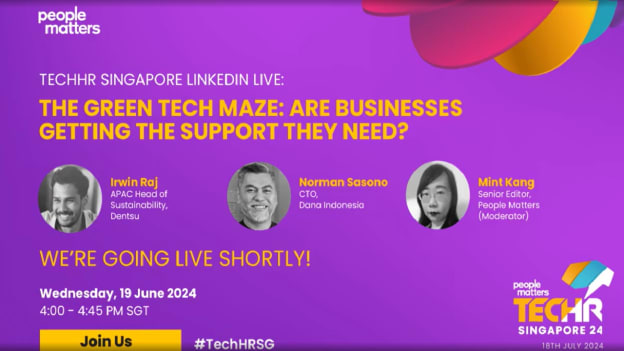The Green Push - Is it sustainable?

As the world confronts the intensifying effects of climate change, the need for a transition to a green economy has become undeniable. The Asia-Pacific region, with its ambitious goals of creating sustainable solutions for businesses to help them achieve net-zero carbon emissions by 2040, finds itself at a critical crossroads.
The ‘Green Push’, popular among green energy enthusiasts, has made governments and companies sit up and take notice of ever-increasing carbon footprints and the rise of Generative AI. The burning questions are: Is Green Technology sustainable? Are businesses getting the necessary support from the governments?
To address these issues, we organised a Linked Live as a pre-cursor to People Matters TechHR Singapore where leaders Irwin Raj, Head of Sustainability, APAC, Dentsu and Norman Sasono, CTO, Dana Indonesia came on the platform to share their expert insights on the issue.
Here are some key insights from the session:
Green technology in current times
As the CTO of Dana Indonesia, a fintech company, Sasono is driving a cashless society in Indonesia and wants to achieve financial inclusion. They are driving sustainability by encouraging over 300,000 people to switch from paper money to digital money to support the environment.
Similarly, at Dentsu, Irwin Raj supports the business in ushering in an era of green technology in the media and advertising industry while decarbonising the sector. In recent times, there has been an array of technologies that agencies and brands are using, including virtual production, AI-based image technology, and data optimisation. These practices, if practised properly and consistently, can become benchmarks of sustainability.
Are businesses getting the necessary support to advance The Green Push?
Singapore was the pioneer in Southeast Asia to introduce a carbon taxation scheme, targeting the promotion of clean energy and the achievement of its net-zero goals. Alongside regulatory measures, the government has launched initiatives like the Green Skill Committee under the Ministry of Trade and Industry to boost industry capabilities and drive innovation. Despite these efforts, many businesses are finding it challenging to keep up with the rapid technological advancements and regulatory shifts.
This has been the case in the APAC region where the challenges of green-washing have risen as the companies are still learning and trying to understand transparent and robust sustainability disclosures.
Consumers, on the other hand, are increasingly more savvy about the brand’s sustainability practices and are holding businesses accountable when they perceive that companies fail to act on their commitments. Therefore, governments need to provide stronger support to these businesses by establishing clear pathways forward.
Is green technology sustainable in reality?
A recent report, “Making AI Less Thirsty” reveals that putting 20-50 prompts in generative AI is equivalent to consuming one 500 ML bottle of water. Addressing this point, Sasono shared how Dana has taken care of sustainability by limiting air travel, limiting office electricity usage and more. The major carbon emission generators are their co-locating data centres, which also use Gen-AI as tools. They are trying to scale the usability of electricity as compared to transactions they can accommodate.
Sasono highlights that one crypto transaction takes 1200 KW of energy to accommodate transactions which is a million more energy-wise when compared to transactions through Visa or Mastercard. Hence, crypto is more likely to be less green than cashless transactions. What has become important for businesses is to shift the dependency from brown energy resources to green energy resources to power data centres
With the rise of AI, the requirements for better GPUs and their usage have increased in manifolds. Businesses should take note of providing better cooling technology to support GPUs and limit their usage for efficient purposes.
Challenges to consider while developing sustainable digital technologies
Irwin highlighted that a lot of governments in Asia are working towards green infrastructure. They have realised that investment is required in digitising as well as utilising green energy resources for sustainability. Gen-AI processes are increasingly being used in data centres which came into play last year. Gen-AI’s carbon footprint is 10-20 times more than say cloud computing, which is prevalent in the APAC region.
The climate in the APAC region is also a great risk for corporates. With the rise of heatwaves, and humidity, these factors are detrimental to constructing stable data centres. These factors force governments to think harder when it comes to finding sustainable solutions for businesses.
Businesses need to sit with their supply value chain partners on how to move to the green economy and what challenges are they facing to achieve the target.
Sasono mentions that it's still difficult for many developing APAC nations to switch readily to green energy because their only source of electricity could be either fossil fuel or thermal energy. Ultimately, cost efficiency is what drives the governments and big players and we need to find a way to influence them to move towards green energy as a cost-efficient option.
The leaders concluded that regulations could be seen as a positive way to bring change in the energy playbook. Governments can give businesses a platform to innovate and find green solutions. It is also important to create versatile processes that include green technology solutions from the start, so they get ingrained in the system, they will continue to have the capacity to update them. Ultimately, for the green push to be sustained, everyone has to think innovative and act versatile.
Keep updating yourself with insights from leaders on key issues in today's workplace by following more content related to #TechHRSG. Register to be part of Asia’s Largest HR & WorkTech Conference! Sign up now!

















